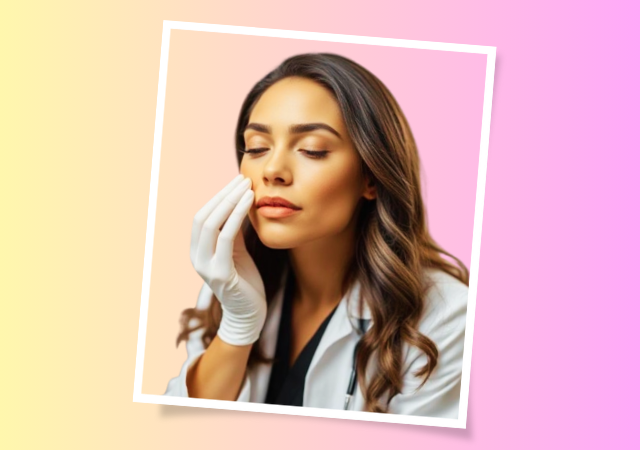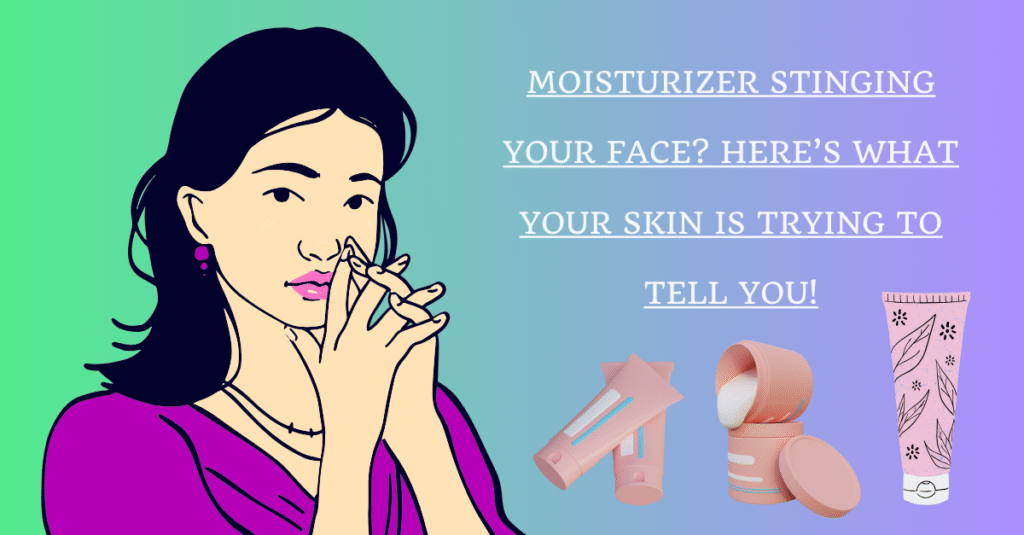Moisturizer Stinging Your Face? Here’s What Your Skin Is Trying to Tell You!
You just washed your face, patted it dry, and applied your favorite moisturizer—only to feel an unexpected burning, stinging, or tingling sensation. Instead of relief, your skin feels irritated, maybe even a little red. What’s going on?
If this has happened to you, you’re not alone. Many people assume moisturizers should always feel soothing, so when they don’t, it’s confusing—and sometimes a little alarming. But here’s the truth: Your skin doesn’t sting for no reason. That discomfort is a signal, a warning that something isn’t right.
In this article, we’ll dive deep into why moisturizers sometimes burn, what your skin is trying to communicate, and—most importantly—how to fix it. By the end, you’ll know exactly which ingredients to avoid, which products to switch to, and how to restore your skin’s comfort.
Why Does My Moisturizer Sting? (The Science Behind the Burn)

Before we get into solutions, let’s understand the root causes of that unpleasant stinging sensation.
1. A Damaged Skin Barrier
Your skin’s outermost layer, the stratum corneum, acts like a protective shield. When this barrier is compromised—due to over-exfoliation, harsh cleansers, weather extremes, or chronic dryness—it becomes more permeable. This means irritants can penetrate deeper, triggering inflammation and that familiar sting when you apply products.
Signs of a damaged barrier:
-
Tightness after washing
-
Increased sensitivity to products that never bothered you before
-
Flakiness or rough texture
2. Harsh or Active Ingredients
Not all moisturizers are created equal. Some contain active ingredients that, while beneficial for some, can be too aggressive for sensitive or compromised skin. Common culprits include:
-
Alcohol (Denatured Alcohol, SD Alcohol 40) – Dries out skin and disrupts the barrier.
-
Fragrances & Essential Oils – Even “natural” scents like lavender or citrus can irritate.
-
Alpha Hydroxy Acids (AHAs) & Beta Hydroxy Acids (BHAs) – Glycolic, lactic, and salicylic acid can be too strong for reactive skin.
-
Retinoids (Retinol, Tretinoin) – While great for anti-aging, they increase sensitivity.
-
Preservatives (Parabens, Phenoxyethanol) – Some people react to these common additives.
If your skin stings only with certain products, check the ingredient list—one of these might be the offender.
3. Allergic Reaction or Contact Dermatitis
Sometimes, the issue isn’t just irritation—it’s a full-blown allergy. Contact dermatitis can develop suddenly, even if you’ve used a product for years. Symptoms include:
-
Redness and swelling
-
Itching or a rash
-
Burning that lingers (not just a quick sting)
Common allergens in moisturizers include fragrances, lanolin, propylene glycol, and certain botanical extracts.
4. Extremely Dry or Dehydrated Skin
When your skin is severely dry, tiny micro-cracks form on the surface. Applying moisturizer to this damaged terrain can feel like pouring lemon juice on a paper cut—painful but temporary. This usually subsides as your skin heals.
5. The Product’s pH Doesn’t Match Your Skin
Your skin’s natural pH is slightly acidic (around 4.5–5.5). If a moisturizer is too alkaline (like some bar soaps) or too acidic (like high-strength exfoliants), it can disrupt your skin’s balance and trigger irritation.
What to Do If Your Moisturizer Burns
Now that you know why it’s happening, let’s talk about what to do next.
Step 1: Stop Using the Product Immediately
This might seem obvious, but some people try to “push through” the discomfort, thinking their skin will “adjust.” Bad idea. Persistent irritation can lead to long-term damage.
Step 2: Rinse with Cool Water
If the burning is intense, gently rinse your face with cool (not ice-cold) water to soothe the skin. Avoid scrubbing or using hot water, which can worsen irritation.
Step 3: Apply a Soothing Agent
While your skin calms down, use a bland, non-irritating product to help repair the barrier. Some safe options:
-
Aloe vera gel (pure, no added alcohol or fragrance)
-
Petroleum jelly (Vaseline) – Locks in moisture without stinging
-
Colloidal oatmeal – Reduces inflammation (look for creams with this ingredient)
Step 4: Switch to a Gentler Moisturizer
Once your skin settles, swap your current moisturizer for one designed for sensitive, reactive skin. Look for:
-
Fragrance-free formulas
-
Ceramides & hyaluronic acid (repair and hydrate without irritation)
-
Minimal ingredient lists (fewer components = lower risk of reactions)
Some dermatologist-recommended brands:
-
CeraVe Moisturizing Cream (ceramides + no fragrance)
-
Vanicream Moisturizing Cream (hypoallergenic, minimal ingredients)
-
La Roche-Posay Toleriane Double Repair (soothing niacinamide)
When to See a Dermatologist

Most cases of moisturizer-related stinging resolve with the right product switch, but sometimes, professional help is needed. See a dermatologist if:
-
The burning doesn’t go away after switching products
-
You develop rashes, swelling, or oozing
-
Your skin stings with almost every product (could indicate rosacea, eczema, or allergies)
A dermatologist can perform patch testing to identify specific allergens and recommend medical-grade solutions.
Preventing Future Stinging: A Skin-Friendly Routine
To avoid this issue in the future, follow these proactive skincare habits:
1. Patch Test New Products
Before slathering a new moisturizer all over your face, test it on a small area (like behind your ear or inner forearm) for 24–48 hours. If no reaction occurs, it’s likely safe.
2. Avoid Over-Exfoliating
Scrubs, acids, and retinoids can weaken your skin barrier over time. If your skin stings easily, cut back on exfoliation (1–2x a week max) and focus on hydration.
3. Look for “Hypoallergenic” & “Fragrance-Free” Labels
These products are formulated to minimize irritation.
4. Apply Moisturizer to Damp Skin
This helps lock in hydration and reduces the chance of irritation.
5. Strengthen Your Skin Barrier Long-Term
Use products with ceramides, fatty acids, and cholesterol to rebuild your skin’s natural defenses.
Final Thoughts: (Moisturizer Stinging Your Face? Here’s What Your Skin Is Trying to Tell You!)
Your skin is smarter than you think. When it stings, it’s not being “dramatic”—it’s telling you something’s wrong. Whether it’s a damaged barrier, a bad reaction, or just the wrong product, the fix is usually simple.
Key Takeaways:
✔ Stinging = a sign of irritation, not normal
✔ Stop using the product immediately
✔ Switch to fragrance-free, gentle formulas
✔ See a dermatologist if it persists
By paying attention to these signals, you can keep your skin calm, hydrated, and happy. No more burning—just healthy, comfortable skin.
FAQs (Quick Answers to Burning Questions)
Q: Can a moisturizer burn and still be good for my skin?
A: Rarely. Some active ingredients (like retinoids) may cause mild tingling, but painful burning is a red flag.
Q: How long does moisturizer burn last?
A: If it’s just irritation, it should fade in 10–30 minutes. If it lingers for hours, you may have an allergy.
Q: Is Vaseline safe if my skin burns?
A: Yes! Petroleum jelly is inert and won’t sting—it’s great for protecting irritated skin.
Hope you enjoyed this article on why your moisturizer might be stinging your face—and what your skin’s really trying to say. Have questions? Slide into my DMs anytime!
Read More: What Are Good Skincare Routines For Women?

My name is Rohit Vagh and I’m a content writer specializing in fashion and lifestyle. I have three years of experience in this field and have written various articles. My writing style is creative and engaging, and I strive to create content that resonates with my readers. I have a deep passion for fashion and am constantly researching the latest trends and styles to make sure my readers are up to date. I’m excited to continue my career in blogging, and I’m always looking for new opportunities in the fashion and lifestyle space.





